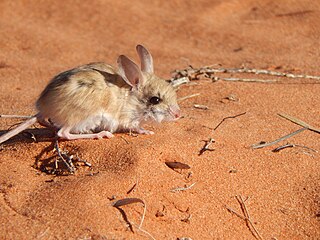
The dusky hopping mouse, is a small rodent endemic to Australia, inhabiting desert regions characterised by sand dunes. Populations have experienced significant declines since the arrival of Europeans, and continue to be subject to threatening processes. It is currently listed as a threatened species.

Alexey Konstantinovich Skvortsov was a Soviet botanist and naturalist, a specialist on amentiferous plants—willows (Salix), poplars (Populus), and birches (Betula) as well as plants of the evening primrose family (Onagraceae), A.K. Skvortsov was, at the same time, well known in Russia as an editor in Priroda (Nature) Magazine (1971–2005) and author of many articles on botany, evolutionary biology, and Darwinism. A botanist of vast erudition, Skvortsov was a surveyor and contributor to many regional floras and a tireless collector of plant specimens. He collected at least 80,000 plant samples while walking across nearly all of the Soviet Union including the most remote regions of Russia and adjacent republics. He traveled in many other countries, including Northern and Central Europe, the United States, India, and China. The establishment of the Herbarium at the Main Botanical Garden in Moscow as a world-class depository with a vast foreign exchange program is largely due to Skvortsov's efforts. He also made additions to the living collection of the Main Botanical Garden. His approach toward botany and evolution inspired him to undertake experimental work in plant introduction. Together with a team of colleagues and students, he successfully worked on domesticating and improving the taste of blue honeysuckles. He also developed a cultivar of an apricot hardy in Moscow. Skvortsov played a role as a conservation advocate proposing and facilitating the establishment of a new national park in his homeland, Kaluga Oblast and Smolensk Oblast of Central European Russia. He cared about the natural heritage of his country, but also about preservation of the Russian language. He spoke out for high language standards in scientific publications.

Chosenia arbutifolia is a flowering plant in the family Salicaceae, native to Korea, Sakhalin, Kamchatka and the Russian Far East.

Salix pedicellata is a species of willow. It is a shrub or small tree to about 6–8 m tall, native around the Mediterranean Sea from Portugal to Lebanon and Syria in the north and from the Canary Islands to Tunisia in the south. Salix canariensis may be treated as a subspecies of S. pedicellata.
Salix uralicola is a willow species described by I.V. Belyaeva. No subspecies are listed in the Catalog of Life.
Salix cupularis is a small shrub from the genus of the willow (Salix) with 1.5 to 2.7 centimeters long leaf blades. The natural range of the species is in China.
Salix dalungensis is a small tree from the genus of willow (Salix) with mostly 4 to 5 centimeters long leaf blades. The natural range of the species is in Tibet.
Salix doii is a shrub from the genus of the willow (Salix) with mostly 3 to 4 centimeters long leaf blades. The natural range of the species is in Taiwan.
Salix donggouxianica is a shrub from the genus willow (Salix) with usually 3.5 to 4.5 centimeters long leaf blades. The natural range of the species is in the northeast of China.
Salix driophila is a shrub from the genus of willow (Salix). The natural range of the species is in China.
Salix ernestii is a species in the genus of willow (Salix) and grows as a shrub. The leaf blades are about 11 centimeters long. The natural range of the species is in China.

Allochronic speciation is a form of speciation arising from reproductive isolation that occurs due to a change in breeding time that reduces or eliminates gene flow between two populations of a species. The term allochrony is used to describe the general ecological phenomenon of the differences in phenology that arise between two or more species—speciation caused by allochrony is effectively allochronic speciation.
Linariantha is a monotypic genus in the plant family Acanthaceae. It was described by Brian Laurence Burtt and Rosemary Margaret Smith.
Salix kirilowiana is a willow species described by Sergei Sergeyevich Sheglejev. Salix kirilowiana is part of the genus Salix, and the family Salicaceae. No subspecies are listed in the Catalog of Life.
Salix saxatilis is a willow species described by Porphir Kiril Nicolai Stepanowitsch Turczaninow.
Salix athabascensis is a species of willow first described by Hugh Miller Raup.
Salix pantosericea is a species of willow first described by Görz in 1934.




